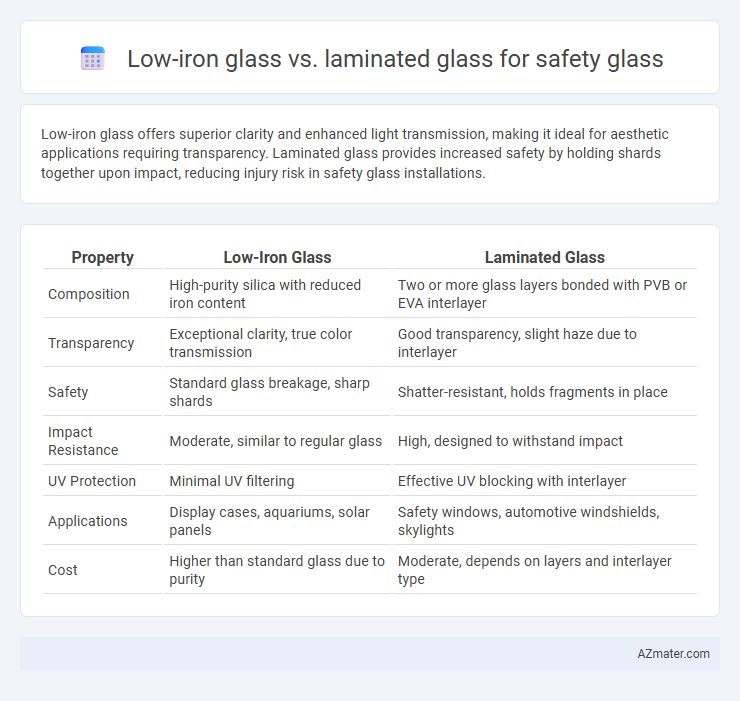Low-iron glass offers superior clarity and enhanced light transmission, making it ideal for aesthetic applications requiring transparency. Laminated glass provides increased safety by holding shards together upon impact, reducing injury risk in safety glass installations.
Table of Comparison
| Property | Low-Iron Glass | Laminated Glass |
|---|---|---|
| Composition | High-purity silica with reduced iron content | Two or more glass layers bonded with PVB or EVA interlayer |
| Transparency | Exceptional clarity, true color transmission | Good transparency, slight haze due to interlayer |
| Safety | Standard glass breakage, sharp shards | Shatter-resistant, holds fragments in place |
| Impact Resistance | Moderate, similar to regular glass | High, designed to withstand impact |
| UV Protection | Minimal UV filtering | Effective UV blocking with interlayer |
| Applications | Display cases, aquariums, solar panels | Safety windows, automotive windshields, skylights |
| Cost | Higher than standard glass due to purity | Moderate, depends on layers and interlayer type |
Overview of Low-Iron Glass and Laminated Glass
Low-iron glass is renowned for its high clarity and reduced greenish tint, making it ideal for applications requiring maximum transparency and color accuracy. Laminated glass consists of two or more layers of glass bonded together with an interlayer, providing enhanced safety by holding shards in place upon impact. Both materials are essential in safety glass solutions, with low-iron glass offering aesthetic clarity and laminated glass ensuring structural integrity and protection.
Composition and Manufacturing Differences
Low-iron glass contains significantly reduced iron content compared to standard glass, resulting in higher clarity and a slight bluish tint, achieved through refined raw materials during the melting process. Laminated glass consists of two or more glass layers bonded with an interlayer, typically polyvinyl butyral (PVB), which enhances safety by holding the shards together upon impact. Manufacturing low-iron glass focuses on raw material purity and melting techniques, whereas laminated glass production involves layering, bonding under heat and pressure, and curing to ensure durability and safety performance.
Optical Clarity: Low-Iron vs Laminated Glass
Low-iron glass offers superior optical clarity due to its reduced iron content, resulting in higher light transmittance and minimal greenish tint compared to standard glass. Laminated glass, while providing enhanced safety through its interlayer, may exhibit slight optical distortions or reduced clarity because of the plastic interlayer. For applications demanding maximum transparency and visual accuracy, low-iron glass is preferred, whereas laminated glass balances safety with acceptable optical performance.
Strength and Impact Resistance Comparison
Low-iron glass offers superior clarity and brightness compared to laminated glass but generally has lower strength and impact resistance. Laminated glass consists of multiple layers with an interlayer that holds shards together upon impact, providing exceptional safety by preventing glass penetration and maintaining structural integrity. For applications demanding high impact resistance and enhanced safety, laminated glass outperforms low-iron glass despite the latter's visual advantages.
Safety Features and Performance
Low-iron glass offers enhanced clarity and reduced green tint, improving visibility and aesthetic appeal in safety glass applications, while laminated glass excels in impact resistance due to its interlayer that holds glass shards together upon breakage, significantly reducing injury risks. Laminated glass provides superior security against forced entry and high-impact events, making it ideal for safety-critical environments, whereas low-iron glass is primarily chosen for visual performance rather than direct safety enhancement. The combination of both materials can optimize safety glass systems by delivering both high optical clarity and robust shatter resistance.
UV Protection and Color Neutrality
Low-iron glass offers superior color neutrality with minimal green tint, making it ideal for applications requiring true-to-life colors, while laminated glass provides enhanced UV protection by incorporating an interlayer that blocks up to 99% of harmful ultraviolet rays. Laminated glass also offers increased safety by holding shattered glass fragments together upon impact, reducing injury risk. Low-iron glass can be combined with UV-blocking interlayers to achieve both high color clarity and effective UV protection in safety glass applications.
Acoustic Insulation Capabilities
Low-iron glass offers superior clarity and transmits more natural light but provides limited acoustic insulation compared to laminated glass. Laminated glass incorporates a PVB (polyvinyl butyral) interlayer that effectively dampens sound vibrations, making it highly efficient for noise reduction. For environments prioritizing acoustic insulation alongside safety, laminated glass is the preferred choice due to its enhanced soundproofing properties.
Applications in Architecture and Interiors
Low-iron glass offers exceptional clarity and is ideal for architectural applications requiring maximum transparency and natural light, such as facades, skylights, and display cases. Laminated glass enhances safety by incorporating a polyvinyl butyral (PVB) interlayer, making it suitable for interior partitions, balustrades, and areas prone to impact or forced entry. Combining low-iron glass with lamination technology maximizes both aesthetic appeal and protection in modern architectural and interior design projects.
Cost Analysis and Economic Considerations
Low-iron glass typically incurs higher initial costs due to its enhanced clarity and purity, making it more expensive than standard laminated glass. Laminated glass offers cost-effective safety benefits by combining layers of glass and interlayers, providing impact resistance and UV protection at a lower price point. Economic considerations favor laminated glass in projects prioritizing budget and durability, while low-iron glass suits premium applications where visual aesthetics justify the higher investment.
Choosing the Right Glass for Safety Needs
Low-iron glass offers high clarity and minimal color distortion, making it ideal for applications where visibility and aesthetics are priorities in safety glass. Laminated glass consists of multiple layers with an interlayer that holds shards together upon impact, providing enhanced protection against breakage and injury. Choosing between low-iron and laminated glass depends on balancing the need for optical clarity with the required safety performance, such as impact resistance and containment.

Infographic: Low-iron glass vs Laminated glass for Safety glass
 azmater.com
azmater.com